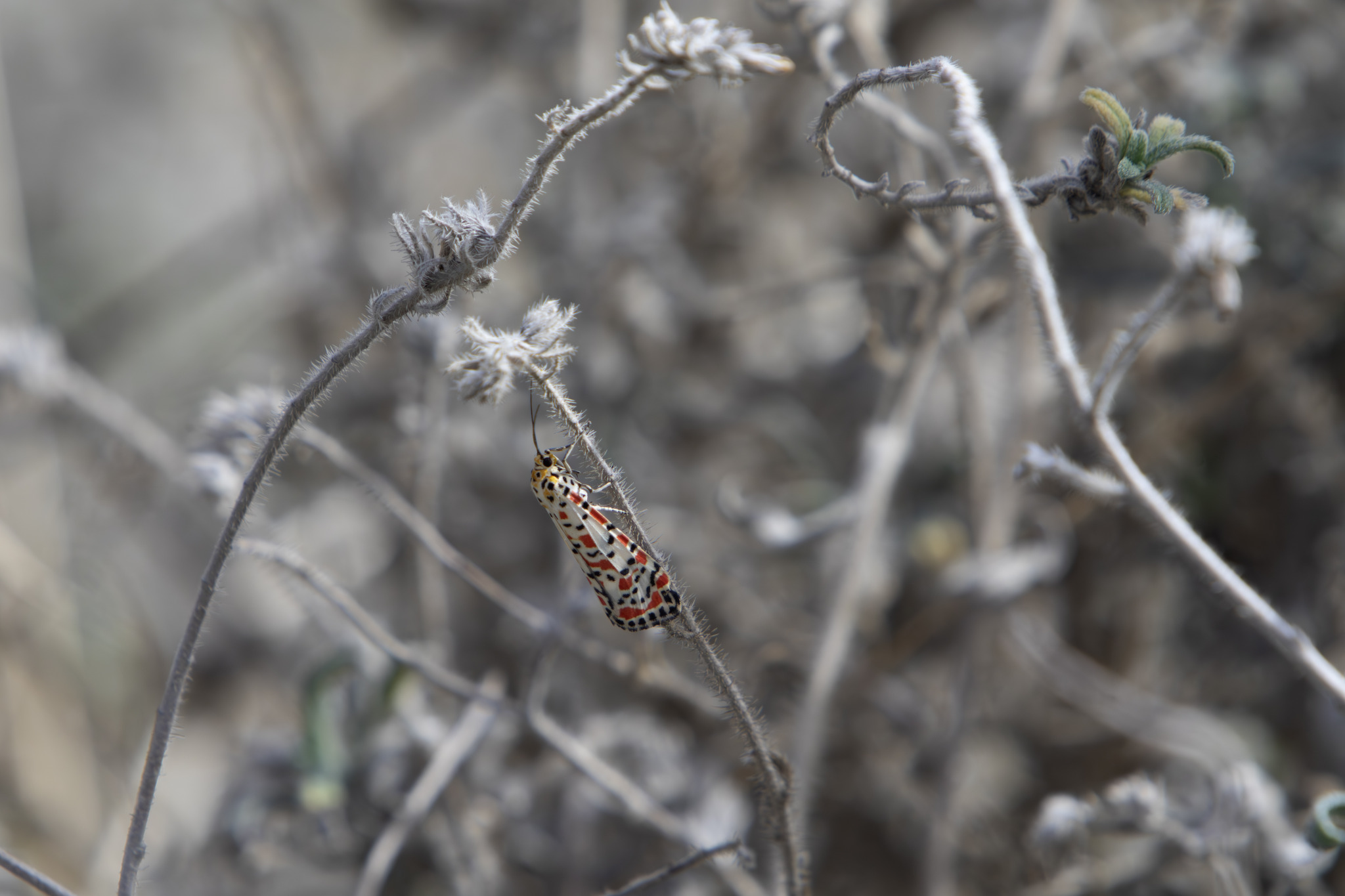The Rattlebox Salt-and-Pepper Moth (Utetheisa lotrix), also known as the Crotalaria Moth, is a brightly colored moth in the family Erebidae. It is primarily found in Asia, Australia, and parts of the Pacific, and is well-known for its relationship with plants from the Crotalaria genus (commonly called rattlebox plants). These plants contain toxic alkaloids that the moth sequesters to make itself unpalatable to predators.
Physical Description:
- Size: The wingspan of the Crotalaria moth ranges from 30 to 40 mm.
- Coloration:
- Forewings: The forewings are white or cream with striking black spots and fine red lines running diagonally across them, giving the moth its “salt-and-pepper” appearance. The combination of these patterns creates a vivid contrast, making it easy to identify.
- Hindwings: The hindwings are bright red with black spots near the edges. These colorful hindwings are often visible during flight but hidden when the moth is at rest.
- Body: The body is slender, predominantly white with black spots, continuing the pattern seen on the wings.
- Aposematic Coloration: The vibrant red and black patterns serve as a warning (aposematic) signal to potential predators, indicating the moth’s toxicity.
Behavior:
- Flight: Crotalaria moths are primarily nocturnal, meaning they are active at night. However, they are occasionally seen during the day, especially when disturbed from vegetation.
- Feeding: Adult moths feed on nectar from various flowering plants, using their long proboscis to extract nectar from deep flowers.
- Chemical Defense: The Crotalaria moth sequesters pyrrolizidine alkaloids from its host plants (Crotalaria species). These chemicals make the moth toxic or distasteful to predators, particularly birds and other insectivores. This chemical defense extends to all life stages, from larvae to adults.
Habitat:
The Crotalaria moth thrives in environments where its host plants, Crotalaria (rattlebox), are abundant. These habitats include:
- Tropical and Subtropical Regions: Found in grasslands, fields, and edges of forests in tropical and subtropical climates.
- Gardens and Agricultural Fields: It is also commonly seen in areas where Crotalaria plants are cultivated or grow as weeds.
Distribution:
The Crotalaria moth is widely distributed in:
- Asia: Particularly in countries like India, Sri Lanka, and Southeast Asian nations.
- Australia: Especially common in northern and eastern regions.
- Pacific Islands: It is found in many islands across the Pacific Ocean.
- Africa: Some populations are also found in parts of Africa.
Life Cycle and Reproduction:
- Eggs: The female moth lays her eggs on the leaves or stems of Crotalaria plants. The eggs are small, round, and pale yellow or cream in color.
- Larvae: The caterpillars are pale with black stripes and orange-yellow markings. These larvae feed voraciously on the leaves, flowers, and pods of Crotalaria plants. As they consume the toxic alkaloids in the plant, they become chemically defended themselves.
- Pupation: The larvae eventually pupate in a silken cocoon, often hidden in leaf litter or crevices near the host plant. After about 1 to 2 weeks, the adult moth emerges.
- Adult Emergence: Adults typically emerge during warm, humid conditions. They have a short lifespan, during which they focus on mating and laying eggs to continue the next generation.
Host Plants:
The primary host plants for the Crotalaria moth are members of the Crotalaria genus, which include various species known as rattlebox plants. These plants contain toxic pyrrolizidine alkaloids, which the moths and their larvae sequester for defense. The moth’s strong association with these toxic plants is essential for its survival and reproduction.
Defense Mechanism:
- Toxicity: By feeding on Crotalaria plants, the larvae and adult moths accumulate pyrrolizidine alkaloids, which make them toxic to most predators. Birds and other predators that attempt to eat the moth often spit it out, deterred by the bitter taste or mild toxicity.
- Aposematism: The moth’s bright coloration acts as a warning signal to potential predators, reducing the chances of being attacked. This strategy of combining visual warning signals with chemical defense is an effective way to avoid predation.
Conservation Status:
The Rattlebox Salt-and-Pepper moth is not currently under threat and is classified as Least Concern by conservation organizations. Its wide distribution and abundance of host plants allow it to maintain healthy populations in many regions. However, habitat loss and the decline of host plants in certain areas could pose a future risk.
Interesting Facts:
- Mating Behavior: During courtship, male Crotalaria moths transfer not only sperm but also pyrrolizidine alkaloids to the female. This provides her with additional chemical defense, which she passes on to her eggs, protecting the next generation.
- Daytime Activity: Although primarily nocturnal, these moths may be active during the day, particularly during the mating season or if disturbed from their resting places.
- Alkaloid Transfer: The larvae acquire toxic chemicals from their host plants, but these chemicals persist in the adult moths as well, providing lifelong protection from predators.
Ecological Role:
The Crotalaria moth plays an important role in the ecosystems where it is found. As both a herbivore (in its larval stage) and a pollinator (in its adult stage), the moth contributes to plant health and reproduction. By feeding on Crotalaria plants, the larvae help regulate the populations of these often weedy plants. As adult moths, they pollinate flowers while feeding on nectar.
Conclusion:
The Rattlebox Salt-and-Pepper Moth (Utetheisa lotrix) is a remarkable species with vibrant coloration, chemical defenses, and a close relationship with its toxic host plants. Its striking appearance and behaviors make it an interesting subject of study in terms of evolutionary defense strategies and plant-insect interactions. The moth’s wide distribution and role in pollination ensure it continues to be an important player in many tropical and subtropical ecosystems.
Views: 1199
Subscribe to the newsletter:
